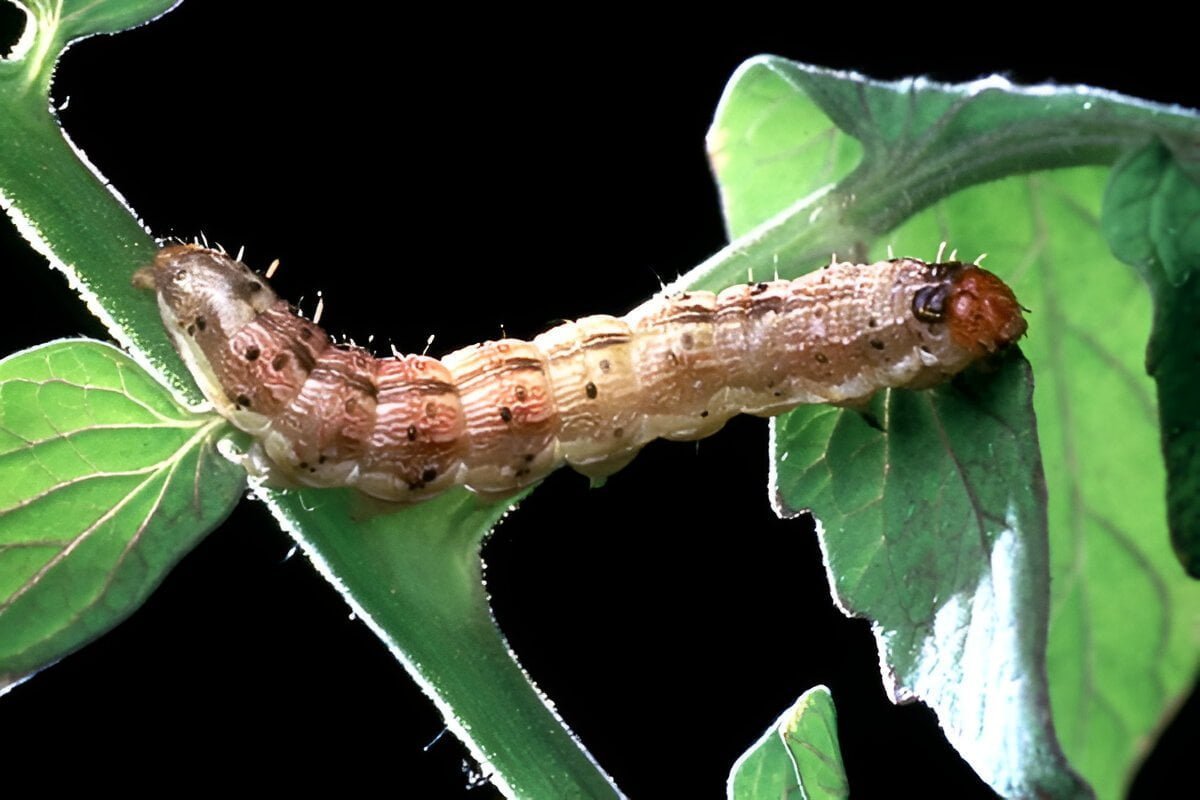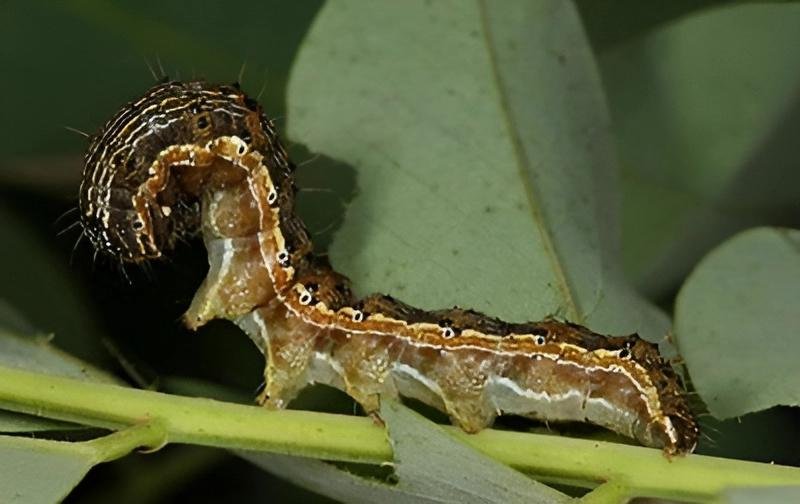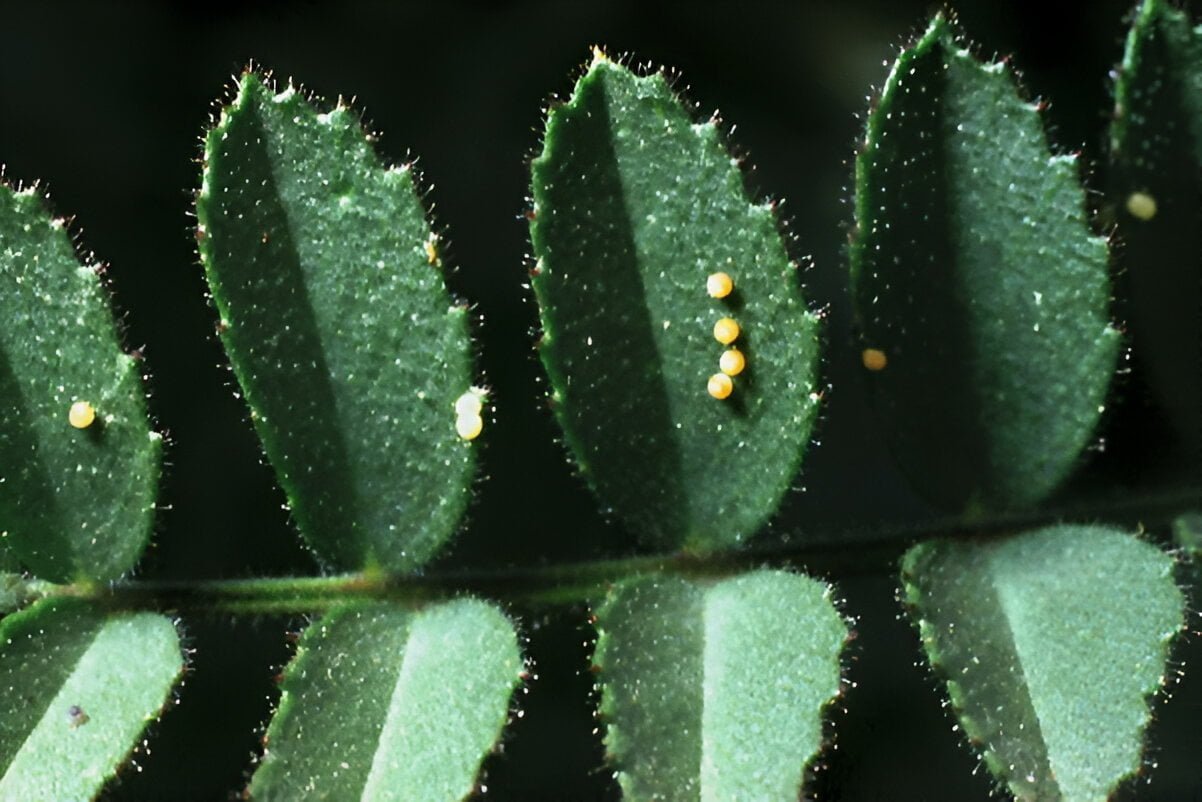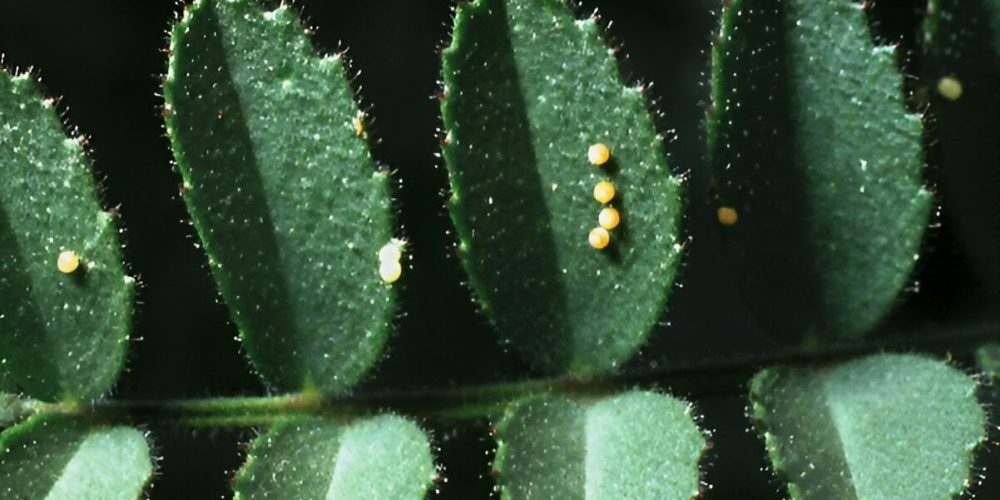Table of contents of the article
ToggleThe American bollworm causes severe damage to zucchini crops by feeding on the fruits and leaves. In this article on your site, World of Plants, we will review how to deal with it effectively.
Symptoms of American bollworm in zucchini
- Scientific name : Helicoverpa armigera
- the family : lepidoptera
- In the first stages, the larva attacks the leaves and licks the skin, then feeds on the entire leaf blade.
- It attacks the buds and young fruits and observes the black insect remains.

Description of the insect
The distance between the tips of the wings is 3.5-4 cm. The color of the male is greenish-gray, while the female is yellowish-brown. The front wings have decorations, and along the outer edge there is a line consisting of 7-8 black dots, and near the terminal third of the wings there is a wide, transverse brown stripe, distinguished by the presence of clear spots with a black center. At the base of the hind wings there is a dark area, and the rest of the wings are light in color.
Caterpillar: When fully developed, it reaches a length of 3-3.5 cm and is yellow or greenish in color. It is equipped with three pairs of thoracic legs and five pairs of false abdominal legs... The head of the caterpillar is yellow-brown in color, and there is a double longitudinal line on the surface of the caterpillar’s body.
The pupa: Its color is brown and its length ranges between 1.5-1.7 cm. It is contained in a cocoon.



Causes of American bollworm in zucchini
- Not taking care of planting at appropriate distances, and planting it at a very high density, which exhausts the plant and deprives it of water, food and air.
- Climatic conditions (high temperature and humidity help the spread of the pest).
- Failure to establish an appropriate irrigation program, and relying on random irrigation.
- The presence of harmful weeds in the field.
- The presence of plant waste in the field and not removing it.
- Failure to treat the soil before planting (plowing, hoeing, leveling).
- The presence of infected neighboring crops.
Suitable conditions for the spread of the American bollworm in zucchini
Growth is faster at high temperatures, reaching 38 degrees Celsius, and larval activity and feeding stop when temperatures drop below 12 degrees Celsius.
Development cycle of the American bollworm in zucchini
- First instar larvae feed on soft leaves, creating small holes. When it reaches the second instar, it can penetrate the fruit through a small hole, often filled near the stem.
- About 4-6 weeks to develop from egg to adult in summer, and 8-12 weeks in spring or fall.
- The fertilized eggs hatch within about three days during warm weather (average 25°C) and 6-10 days in cooler conditions, and change from white
- From brown to black head stage.
- Eggs are laid individually on young shoots near buds, flowers, fruits or on leaves.
- They usually go through six larval instars, although in certain circumstances five or seven instars may occur.
- Fully-grown larvae crawl to the base of the plant, tunnel up to 10 cm into the soil and form a chamber in which they pupate.
- Overwintering pupae take much longer to emerge.
- Adult individuals appear when the soil temperature at a depth of 10 cm rises more than 10 m. This usually occurs in the first or second decade of May. The butterfly is active at night and lives between 3 and 28 days.

Losses of the spread of the American bollworm in zucchini
- The fruits stop growing, ripen quickly and fall.
- Huge economic losses, about 90%.
- Injury to nearby crops.
Control strategy
Preventive measures to prevent the occurrence of American bollworm in zucchini
- Good agricultural operations, including cultivation, weed removal, and soil leveling.
- Physical factors can greatly influence egg survival and larval development. Heavy rain and wind can blow the eggs away from the leaves. High temperatures can dry out and kill eggs and very young larvae.
- Follow the appropriate agricultural cycle that ensures that insect hosts are not provided in one area and in a sequential growth manner.
- Early agriculture.
- Early harvest of the crop.
- Cultivation of resistant varieties
Organic control against American bollworm in zucchini
- The use of some parasites for larvae, such as Bracon brevicornis, and among the egg parasites are species of Trichoderma sp.
- Use plant traps
- Using light traps with double waves to monitor and control the insect
Chemical control against the American bollworm in zucchini
- The adult insect fights at the beginning of the season after it emerges from the hibernation, and the spraying is repeated after a week using infectious contact pesticides.
- Use soil insecticides to control larvae.
In conclusion, we would like to note that we, at the world of plants website, offer you all the necessary services in the world of plants, we provide all farmers and those interested in plants with three main services::-
- Artificial intelligence consulting service to help you identify diseases that affect plants and how to deal with them.
- Blog about plants, plant diseases and care of various crops ... You are currently browsing one of her articles right now.
- An application that provides agricultural consultations to clients, as well as a service for imaging diseases and knowing their treatment for free – Click to download the Android version from Google Play Store، Click to download the IOS version from the Apple App Store.
References
- Ali, A., Choudhury, R. A., Ahmad, Z., Rahman, F., Khan, F. R., & Ahmad, S. K. (2009). Some biological characteristics of Helicoverpa armigera on chickpea. Tunisian Journal of Plant Protection, 4(1), 99-106.
- TALEKAR, N. S.; OPENA, R. T.; HANSON, P. Helicoverpa armigera management: a review of AVRDC’s research on host plant resistance in tomato. Crop Protection, 2006, 25.5: 461-467.
- The National Pest Information Network has released a new Integrated Pest Management (IPM) Checklist for grains and is seeking industry feedback.
- Some Biological Characteristics of Helicoverpa armigera on Chickpea – researchgate
- Helicoverpa armigera (cotton bollworm) – cabidigitallibrary
- Life cycle and appearance of Cotton bollworm – koppertHelicoverpa – identification and behaviour – thebeatsheetHelicoverpa armigera management: A review of AVRDC’s research on host plant resistance in tomato – sciencedirect




